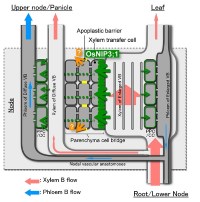Enlarge Image
Preferential delivery of boron to developing tissues in rice
Boron is an essential element for plant growth and development. In particular, developing tissues such as meristem require high amounts of boron for their active growth. However, it is not known how boron is preferentially delivered to these tissues with low transpiration.
Now, Jian Feng Ma and his colleagues at the Institute of Plant Science and Resources report that a transporter (OsNIP3;1) expressed in rice nodes is responsible for the preferential distribution of boron to the developing tissues. OsNIP3;1 is polarly localized at the xylem parenchyma cells of enlarged vascular bundles of nodes facing towards the xylem vessels. Knockout of this gene resulted in decreased distribution of boron to new leaves but increased distribution to old leaves causing inhibition of new leaf growth. Furthermore, this transporter responded to environmental boron changes at both transcriptional and protein levels.
This work revealed a novel mechanism for preferential distribution of boron in plants and will contribute to breed boron -use efficiency crops under boron-limited conditions in future.
Reference:
Authors
Ji Feng Shao, Naoki Yamaji, Xin Wei Liu, Kengo Yokosho, Ren Fang Shen and Jian Feng Ma
Title of original paper
Preferential Distribution of Boron to Developing Tissues Is Mediated by the Intrinsic Protein OsNIP3
Journal, volume, pages and year
Plant Physiology 176, 1739–1750 (2018).
Digital Object Identifier (DOI)
10.1104/pp.17.01641
Journal website
http://www.plantphysiol.org/
Affiliations
Institute of Plant Science and Resources, Okayama University
Department website
http://www.rib.okayama-u.ac.jp/plant.stress/index.html


